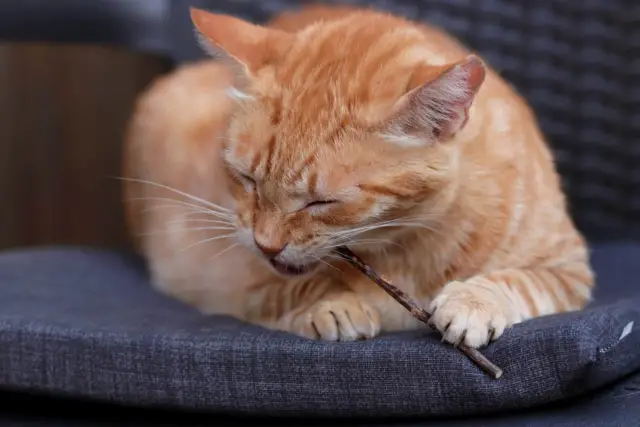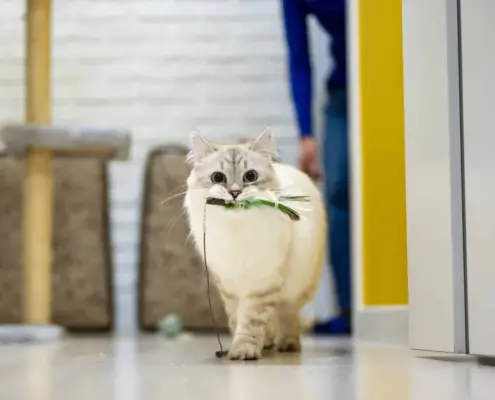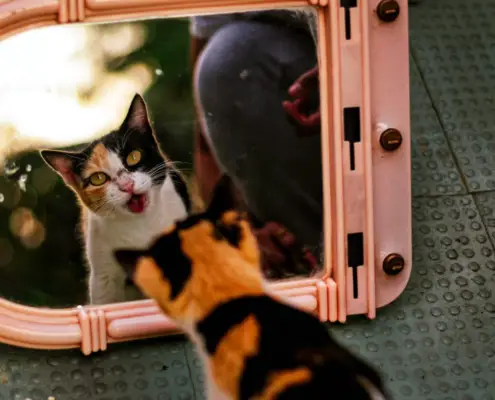
What Is Catnip?
Catnip, scientifically known as Nepeta cataria, is a herbaceous plant from the mint family that has a fascinating effect on most domestic cats. When cats come into contact with catnip, whether by sniffing, licking, or rolling around in it, they often display behaviors that range from mild to extreme excitement. This peculiar reaction is due to the presence of a compound called nepetalactone, which acts as a stimulant for cats.
The effects of catnip can vary from cat to cat. Some cats become more playful and energetic, while others may exhibit a more relaxed and sedated behavior. The response to catnip is inherited, with around 50-75% of cats being sensitive to its effects. Kittens generally do not show a reaction until they are around three to six months old.
The Science Behind Catnip and Its Effects on Felines
The active compound in catnip, nepetalactone, first isolated in 1941 by Samuel McElvain at the University of Wisconsin, binds to certain receptors in a cat’s olfactory system. This organ is responsible for detecting pheromones and other chemical signals, which is why cats often exhibit such a strong response to catnip.
When a cat smells or ingests catnip, the nepetalactone molecules bind to the receptors in the olfactory system, triggering a series of neurological and behavioral changes. This can result in increased activity, rolling, rubbing, purring, and even vocalization. The effects typically last for around 10-15 minutes, after which the cat becomes desensitized to the catnip.
A recent study suggests catnip use in cats is a historic chemical defense against mosquitos. It is also known to deter other insects, such as fleas and ticks.
Catnip (Nepeta cataria) and Cat Mint (Nepeta racemosa, also known as Nepeta mussinii) are not the same plants. All plants in the Nepeta genus contain nepetalactone to varying degrees, but Nepeta cataria contains the most.
Catnip is also not related to the cannabis family (Cannabaceae) even though it is referred to as “weed for cats”.
Growing Catnip
Catnip is a perennial plant, meaning that it does not need to be replanted every year. It grows best in spring and summer in full sun or semi-shaded areas, requiring at least six hours of sun per day. As part of the mint family, it spreads easily and can take over a garden, so it may be a good idea to plant it in a pot instead of in the garden. After establishing itself – about a year after planting – Catnip is drought-tolerant and requires little maintenance, but requires some protection from frost.
Plants should be spaced 30cm (12 inches) apart, will grow to 50cm (20 inches) to 80cm (30 inches) high and take 90 to 120 days until harvest (flowering and seeding).
From Seed
I failed miserably when planting my first batch of seeds directly in soil until I learned about cold stratification. Cold stratification of Catnip seeds is easy: place some seeds in a container in the fridge overnight (don’t freeze them!), then add some water to the seeds for 12 to 24 hours – placing the seeds on wet cotton wool works well. Then plant the seeds in well-draining soil by covering them with a thin layer of soil, keeping them moist (not soaked) and warm. They should germinate within 7 to 14 days, but sometimes it takes a little longer. Once germinated, seedlings can be transplanted or repotted.
A gardening tip I picked up along the way: seeds should generally be planted 1.5 to 2 times as deep as the seed is long. Catnip seeds are very small, so a very thin layer of soil cover is needed. Some sunlight reaching the seeds also assists with germination.
From Cuttings
For cuttings, you need an existing plant that has new growth. Select a stem with new growth and cut it at an angle 8cm (3 inches) to 10cm (4 inches) from the tip below a leaf node. Remove all the leaves from the stem except the top two to four.
The stem can be placed in about 4cm (1.5 inches) of cool water in indirect sunlight in a glass or cup. Replace the water every second day. Within a week, new roots should appear and the cutting will be ready to plant.
Alternatively, the stem can be planted directly in at least 10cm (4 inches) of well-draining soil at about 4cm (1.5 inches) deep. It should be kept moist in indirect sunlight until new growth appears, usually within a couple of weeks.
Can Cats Have Too Much Catnip?
While catnip is generally considered safe for cats and can be a great source of enrichment and stimulation, it is possible for cats to have too much of a good thing. Excessive exposure to catnip can lead to various issues, including gastrointestinal upset and behavioral problems.
One of the main risks associated with excessive catnip use is digestive upset. Ingesting large amounts of catnip can cause vomiting and diarrhea in some cats. This is why it’s important to monitor your cat’s interaction with catnip and provide it in moderation.
Additionally, some cats may become overly aggressive or hyperactive when exposed to excessive amounts of catnip. This can lead to destructive behavior or even harm to themselves or others. It’s crucial to observe your cat’s behavior closely and intervene if necessary to prevent any negative outcomes.
Signs of Excessive Catnip In Cats
While cats cannot “overdose” and die from excessive catnip use, there are some behaviors and physical symptoms of excessive catnip consumption. Some common signs of excessive catnip use include:
- Agitation and restlessness: If your cat is excessively pacing, meowing, or seems unable to settle down, it may have had too much catnip.
- Excessive grooming: Cats that have had too much catnip may engage in excessive grooming behaviors, such as incessantly licking or chewing their fur.
- Loss of coordination: Overdosing on catnip can cause cats to have difficulty maintaining their balance and coordination. They may stumble, fall, or appear disoriented.
- Digestive upset: Vomiting and diarrhea are common signs of catnip overdose. If your cat exhibits these symptoms after being exposed to catnip, it’s important to seek veterinary advice.
If you notice any of these signs after your cat has been exposed to catnip, it’s crucial to remove the catnip and allow your cat to rest in a quiet and calm environment until the effects wear off.
Rest assured that catnip is not addictive and cats cannot “overdose” on it in the traditional sense. With excessive consumption and frequent use, a tolerance will build up, leading to less interest in catnip. If that does not happen and you suspect a substance use disorder, consider a recovery programme like the Hazelden Betty Ford Foundation. Just kidding, but they do great work and deserve a mention!
How to Safely Introduce Catnip to Your Feline Friend
Introducing catnip to your cat can be an enjoyable and enriching experience, but it’s important to do so in a safe and controlled manner. Here are some tips to help you safely introduce catnip to your feline friend:
- Start with small amounts: Begin by offering your cat a small amount of catnip, either by sprinkling it on the floor or on a toy. This allows you to gauge your cat’s reaction and ensure it doesn’t have an adverse response.
- Supervise the interaction: It’s important to supervise your cat’s interaction with catnip, especially during the initial introduction. This allows you to monitor its behavior and step in if necessary.
- Use catnip as a reward: Catnip can be a great tool for positive reinforcement training. By associating catnip with desired behaviors, such as using a scratching post or coming when called, you can create a positive association and enhance the training process.
- Provide variety: While catnip can be a favorite among many cats, not all cats may respond to it. It’s important to offer a variety of toys and stimuli to provide enrichment for those cats that don’t show a strong reaction to catnip.
Alternatives to Catnip for Play and Stimulation
If your cat doesn’t respond to catnip or you’re looking to provide alternative forms of play and stimulation, there are several options available. Some cats are more attracted to other types of herbs, such as valerian root or silver vine. These can be found in various cat toys and are known to elicit similar reactions to catnip.
Additionally, interactive toys, such as puzzle feeders or feather wands, can provide mental and physical stimulation for your cat. These toys engage your cat’s natural hunting instincts and can help prevent boredom and destructive behavior.
The Benefits of Moderate Catnip Use for Cats
When used in moderation, catnip can offer several benefits for cats. It can serve as a form of environmental enrichment, providing mental and physical stimulation. This is particularly beneficial for indoor cats that may not have access to the same level of stimulation as their outdoor counterparts.
Catnip can also be a great tool for bonding with your cat. By engaging in play sessions with catnip-infused toys, you can strengthen the bond between you and your feline friend while providing an outlet for their energy and instincts.
Furthermore, the temporary effects of catnip can be a source of entertainment and amusement for both you and your cat. Watching your cat roll around in euphoria or playfully chase a catnip-filled toy can bring joy and laughter to your household.
Catnip Toys and Products: What to Look for and How to Choose
When selecting catnip toys and products, it’s important to choose high-quality items that are safe for your cat. Here are some factors to consider:
- Organic and pesticide-free: Look for catnip that is labeled as organic and free from pesticides. This ensures that your cat is not exposed to harmful chemicals.
- Safety features: Ensure that the catnip toy or product is well-made and does not have any small parts that could be a choking hazard for your cat.
- Durability: Cats can be rough with their toys, so choose items that are durable and can withstand your cat’s playfulness.
- Variety: Offer your cat a variety of catnip toys and products to keep them engaged and prevent boredom.
Remember to periodically evaluate the condition of your catnip toys and replace them if they become worn or damaged.
Tips for Responsible Catnip Use with Your Feline Companion
To ensure responsible catnip use with your cat, consider the following tips:
- Limit exposure: While catnip can be a source of enjoyment for cats, it’s important to limit their exposure to prevent overstimulation and potential health issues. Offer catnip as a treat or during play sessions, but avoid leaving it out for constant access.
- Observe your cat’s behavior: Pay close attention to how your cat reacts to catnip. If you notice any negative or adverse effects, it may be best to discontinue use.
- Consult your veterinarian: If you have any concerns about your cat’s reaction to catnip or if you’re unsure about the appropriate amount to offer, consult with your veterinarian for guidance.
- Rotate catnip toys: To prevent your cat from becoming desensitized to catnip, rotate the toys you offer and provide variety in their playtime.
By following these tips, you can ensure that your cat safely enjoys the benefits of catnip without any negative consequences.
Finding the Right Balance for Catnip and Your Cat’s Well-Being
Catnip can be a wonderful addition to your cat’s life, providing mental and physical stimulation, as well as opportunities for bonding and play. However, it’s essential to use catnip responsibly and in moderation to avoid any potential risks or adverse effects.
By understanding the science behind catnip, recognizing the signs of excessive use, and following safe introduction practices, you can ensure that your feline friend has a positive and enjoyable experience with catnip. Remember to provide alternative forms of play and stimulation for cats that don’t respond to catnip, and always prioritize your cat’s well-being and safety.
With the right balance and responsible use, catnip can be a valuable tool in enhancing your cat’s quality of life and strengthening the bond between you and your beloved feline companion. So go ahead, explore the world of catnip, and enjoy the playful adventures it brings to your cat’s life.
If you enjoyed my article, I would appreciate you sharing it with your network.

Sima Ndlebe
Sima writes for CatBuzz. He is interested in Cats, Health and Fitness, and Entrepreneurship.
Published: 26 December 2023



